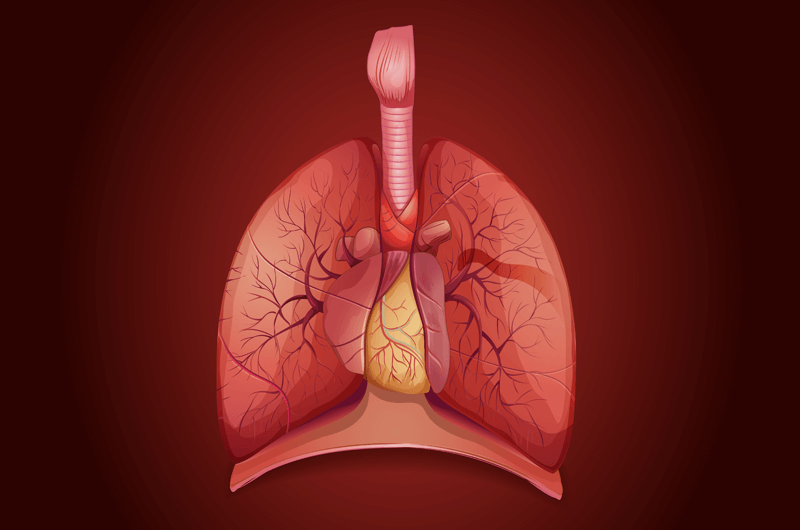Pneumonitis is a general term that refers to inflammation of lung tissue. Also referred to as hypersensitivity pneumonitis, this disorder is caused when a person has an allergic reaction in their lungs caused by certain inhaled substances. This inflammation makes it harder for the lungs to function properly and may sometimes even damage the lungs permanently. Pneumonitis is not a specific disease but a sign of an underlying problem. The condition tends to occur when an irritating substance of any kind is introduced into the lungs causing the tiny air sacs in the lungs to become inflamed and lead to breathing difficulty. In most cases, lifestyle factors such as occupation, location, age and gender can increase the risk of this disease. A person who works with harsh chemicals or irritants is more likely to develop pneumonitis than others. Some other causes include – radiation treatment, drugs and antibiotics, molds and bacteria and exposure to birds, bird feathers, or excrement. If diagnosed early, hypersensitivity pneumonitis is treatable by avoiding exposure to the environmental substances or with medicines such as corticosteroids that reduce inflammation. For accurate clinical documentation of this lung condition, physicians can benefit from the services of medical billing outsourcing companies.
Signs and Symptoms of Pneumonitis
One of the most common symptoms of hypersensitivity pneumonitis is shortness of breath accompanied by a dry cough. If left untreated, the condition gradually develops into chronic pneumonitis, which can result in scarring (fibrosis) in the lungs. Common signs and symptoms include –
- Fatigue
- Loss of appetite
- Unintentional weight loss
- A burning sensation in the chest
- Fever
- Tiredness
The initial symptoms may last for as little as 12 hours, but may continue for several days in some individuals.
Diagnosing and Documenting Pneumonitis
As pneumonitis symptoms are similar to that of other lung disorders, it is difficult to accurately diagnose the same. As part of the initial diagnosis, physicians will conduct a detailed physical exam and evaluate the patient’s previous medical history. They will try to find out the exact substances or factors the patient has come into contact with that could cause pneumonitis. To distinguish pneumonitis from other lung disorders, physicians may conduct one or more of the following tests –
- Blood tests to evaluate the levels of white blood cells in the body
- Diagnostic imaging tests such as Chest X-ray and Computerized tomography (CT) to check for fluid or inflammation in the lungs
- Pulmonary function tests such as – Spirometry, Bronchoscopy, Surgical lung biopsies and Oximetry
Treatment advice for pneumonitis in most cases will involve recommendation from the physicians to eliminate or reduce exposure to the allergen or chemical irritating your lungs. Avoiding the irritant is often enough to prevent the pneumonitis from reoccurring or getting worse. However, this may not be always possible, especially when chemotherapy or radiation treatments are involved.
Pulmonologists who treat pneumonitis rely on reputable medical billing companies to code the condition accurately. The following ICD-10 codes are relevant with regard to pneumonitis–
- J67 – Hypersensitivity pneumonitis due to organic dust
- J67.0 – Farmer’s lung
- J67.1 – Bagassosis
- J67.2 – Bird fancier’s lung
- J67.3 – Suberosis
- J67.4 – Maltworker’s lung
- J67.5 – Mushroom-worker‘s lung
- J67.6 – Maple-bark-stripper’s lung
- J67.7 – Air conditioner and humidifier lung
- J67.8 – Hypersensitivity pneumonitis due to other organic dusts
- J67.9 – Hypersensitivity pneumonitis due to unspecified organic dust
- J68 – Respiratory conditions due to inhalation of chemicals, gases, fumes and vapors
- J68.0 – Bronchitis and pneumonitis due to chemicals, gases, fumes and vapors
- J68.1 – Pulmonary edema due to chemicals, gases, fumes and vapors
- J68.2 – Upper respiratory inflammation due to chemicals, gases, fumes and vapors, not elsewhere classified
- J68.3 – Other acute and sub acute respiratory conditions due to chemicals, gases, fumes and vapors
- J68.4 – Chronic respiratory conditions due to chemicals, gases, fumes and vapors
- J68.8 – Other respiratory conditions due to chemicals, gases, fumes and vapors
- J68.9 – Unspecified respiratory condition due to chemicals, gases, fumes and vapors
- J69 – Pneumonitis due to solids and liquids
- J69.0 – Pneumonitis due to inhalation of food and vomit
- J69.1 – Pneumonitis due to inhalation of oils and essences
- J69.8 – Pneumonitis due to inhalation of other solids and liquids
Prevention of pneumonitis may involve making certain lifestyle changes to protect health. If the condition is not well controlled over time, this chronic inflammation can cause irreversible scarring of the lungs that may severely impair its ability to function. Lifestyle changes to prevent this chronic lung condition include – avoiding chemical irritants and wearing a face mask when dealing with birds, bacteria, or mold of any kind as much as possible.
Treating and managing patients with pneumonitis and taking care of the necessary documentation simultaneously can be quite demanding for physicians. Managing pulmonary medical billing and coding will be much easier for pulmonologists who partner with a medical billing and coding service provider. With an experienced team of AAPC-certified coders and billing professionals to assist them, medical coding and timely claim submission would be easier; these services would also help ensure appropriate reimbursement.




